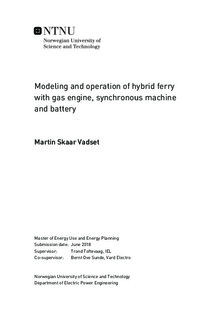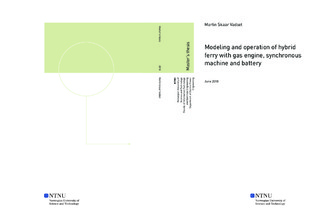| dc.description.abstract | In this master's thesis, a direct current (DC) hybrid energy system for a liquified natural gas (LNG) ferry is developed and studied. The system is constructed in Matlab and Simulink and consists of two generator sets with gas engines and synchronous generators, six-pulse diode rectifiers, battery storage, bi-directional DC/DC converter and a load. A control structure for the gas engine, excitation system of the generators and battery converter is developed. The gas engine is modelled with the GAST model and a speed governor, while the excitation system is modelled with the AC1A excitation model and droop control with respect to the DC link voltage. Two control methods are developed for the control of the converter, droop and peak shaving. The performance of the controllers and system is tested for generator sets with droop control, generator sets and battery with droop control and peak shaving with generator sets and battery. The specific energy consumption (SEC) of the gas engines is then calculated for fixed and variable speed during stationary operation with respect to the engine speed and engine load. The SEC values are compared for the cases and with respect to variable and fixed speed.
Variable speed resulted in lower SEC for all cases presented, and the highest difference was for the case with the peak shaving method. For the droop control configuration between the generator sets and the battery, the SoC limits of 80-65 % was violated with a δBat equal 0.05. Then, the options for the system were to increase δBa and reduce the contribution from the battery or install a larger battery that is able to contribute the load power without violating the SoC limits. With the peak shaving method, stored power was available in the battery since the SoC was in the range of 80-76 %. With the discharge and charging power (±1800 kW) delivered from the battery, a smaller battery with a capacity of 720 kWh could obtain the same operation. An opportunity to reduce the SEC of the operation is to develop a control system for connecting and disconnecting generators sets, which makes the generator sets operate at a more optimal loading rate. | en |

